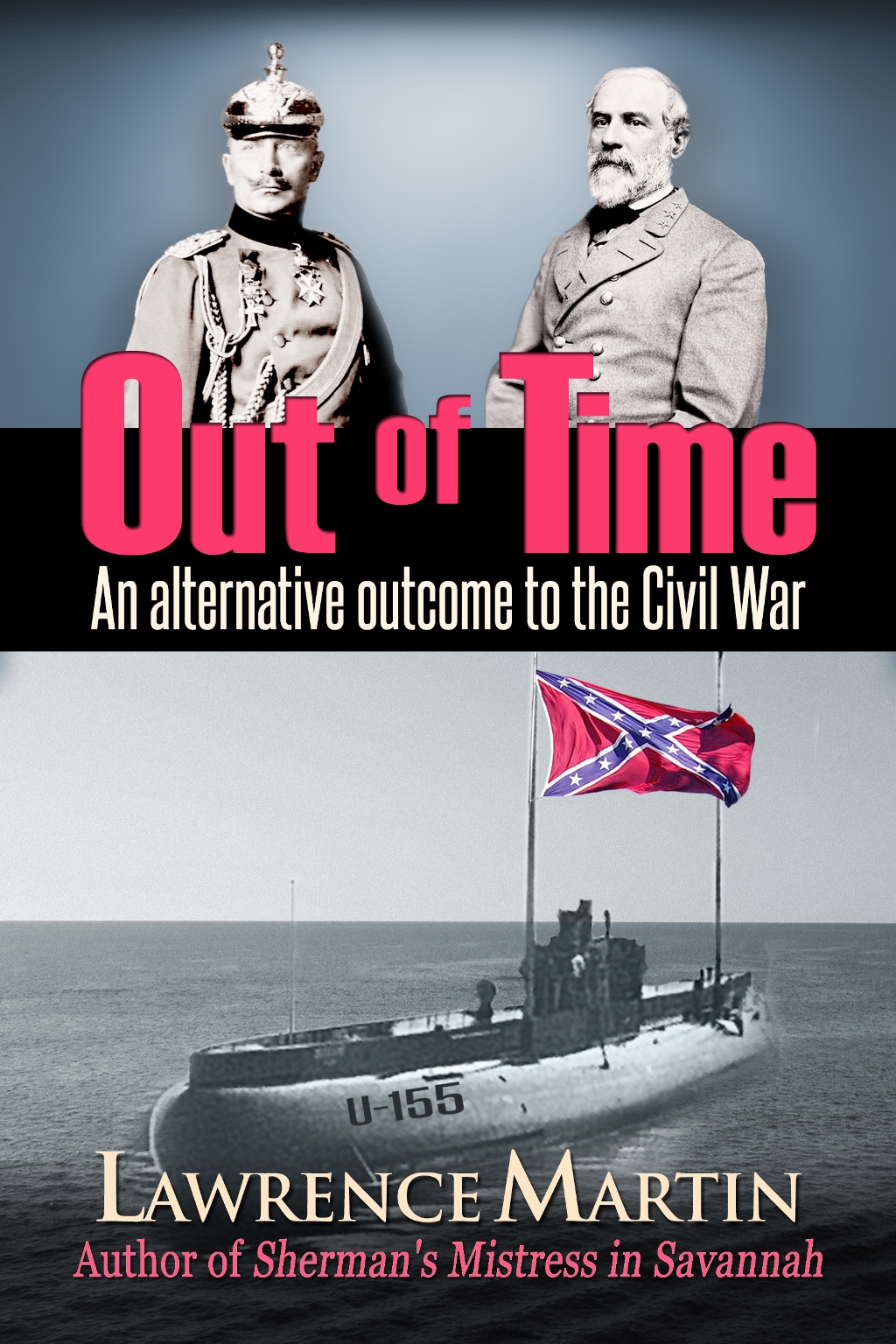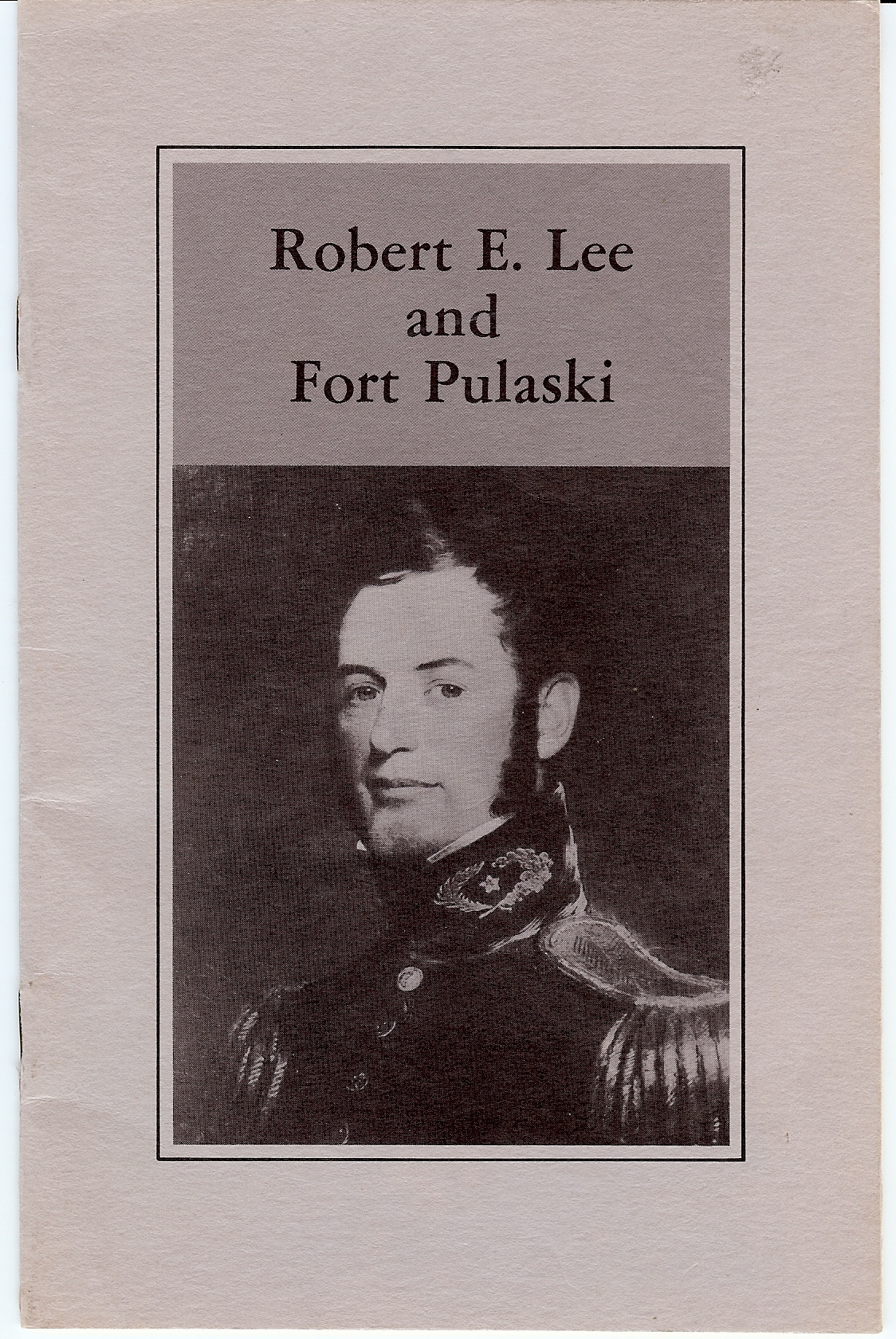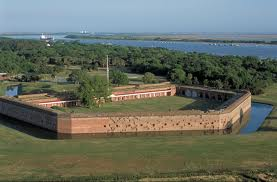 INTRODUCTION:
The Battle of Fort Pulaski took place April 10 & 11, 1862 on coastal islands about 12 miles east of Savannah, Ga. The fort, located on Cockspur Island, was occupied by Confederates at the time. The attacking Union forces, mainly located on nearby Big Tybee Island, took over the fort after less than two days of bombardment. Though short and with relatively few casualties, the battle was highly consequential. The Union victory showed that all masonry forts were henceforth obsolete against the new rifle guns, and it effectively cut off Savannah as a port for the duration of the civil war. The photo above shows the fort as it is today, with holes in the walls from the 1862 bombardment. What follows is a detailed time line of the battle, using both internet and primary sources.
INTRODUCTION:
The Battle of Fort Pulaski took place April 10 & 11, 1862 on coastal islands about 12 miles east of Savannah, Ga. The fort, located on Cockspur Island, was occupied by Confederates at the time. The attacking Union forces, mainly located on nearby Big Tybee Island, took over the fort after less than two days of bombardment. Though short and with relatively few casualties, the battle was highly consequential. The Union victory showed that all masonry forts were henceforth obsolete against the new rifle guns, and it effectively cut off Savannah as a port for the duration of the civil war. The photo above shows the fort as it is today, with holes in the walls from the 1862 bombardment. What follows is a detailed time line of the battle, using both internet and primary sources.
1812
After the War of 1812 President Madison decides a series of coastal forts is needed to prevent invasion of the U.S. He commissions a European to design what will be known as the
3rd System of Forts. Fort Pulaski, on Cockspur Island at the mouth of the Savannah River, is one of these forts. Below is an 1860s map of the region, showing the fort on Cockspur Island. Savannah (not shown on this map) is just to the left of Fort Jackson, about 12 miles upriver from Fort Pulaski.

1828
December, 1828 - Preliminary surveys on design of the fort are begun by Army Engineer Major Samuel Babcock (West Point Class of 1808).
1829
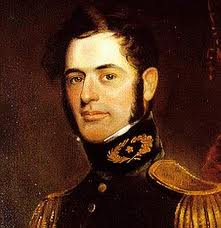
August 11, 1829 - Robert E. Lee (above), a new West Point Graduate (2nd in his 1829 class) receives orders to report to Cockspur Island, Georgia in November; there, he will be assigned as assistant engineer to Major Babcock, to help lay groundwork for the new fort.
Early November, 1829 - Lee arrives in Savannah. Major Babcock has been up north since the summer months, and so Lee spends time with friends in the city.
December 23, 1829 - Major Babcock arrives in Savannah and Lee meets him for first time.
1830
January-May, 1830 - Lee and Babcock work on drainage ditches, a wharf for ships to dock on Cockspur Island and barracks for the workers. However, Babcock is ill for much of this period and most of the responsibility falls on Lee. (Babcock left the fort that summer, never to return. He died in 1831.) Lee leaves Savannah during the summer and returns to his native Virginia.
November 10, 1830 - Lee returns to Savannah, to resume work on the fort.
1831
January, 1831 - Army engineer
Joseph K. Mansfield (1803 - 1862) arrives to oversee fort construction.
January - April, 1831. Lee undertakes detailed survey of Cockspur island, covering all the terrain. He is then reassigned to Hampton Roads, VA. He will not return until 1861.
1832-1847
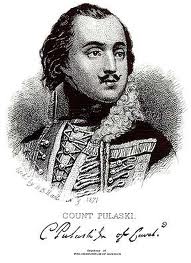
The fort is constructed during a 15-year period, under the capable surpervision of Major Mansfield. During construction it is named for
Casimir Pulaski. Pulaski (above) was a Polish cavalry officer who died from injury received while fighting for the American Revolution (see
Siege of Savannah). Pulaski was wounded October 9, 1779 and died two days later.
1847 - 1860
Guns are installed but no troops are assigned to the fort. Maintenance of the fort is largely abandoned during this period. Only a caretaker and ordinance officer are assigned during these years.
1860
November, 6. 1860 - Abraham Lincoln
is elected 16th U.S. president, precipitating South Carolina to secede from the Union.
December 20, 1860 - South Carolina
secedes from the Union. Announcement is from Charleston Mercury, 1860 (click on
poster for larger image).
January 2, 1861 (Wednesday) - After South Carolina's bold move Georgia politicians also strongly consider secession, and realize Fort Pulaski could soon be occupied by Union forces against them. Governor Brown issues an order for the Georgia militia, under
General Alexander Lawton, to "take possession of Fort Pulaski" and to "hold it against all persons, to be abandoned only under orders from me or under compulsion by an overpowering hostile force."
January 3, 1861 - In the morning the steam ship Ida sails from Savannah to Cockspur Island, landing that afternoon with 150 troops. The Confederates seize the fort without firing a shot. Only a caretaker and an ordinance officer are in the fort. While the fort itself is in good shape the grounds are overgrown with vegetation, the guns are in disrepair and the moat is filled with silt. Over the next several months the Confederates proceed to rehabilitate the fort.
Left: Civil War map showing location of Ft. Pulaski at mouth of Savannah River.
(Click here for larger image of map.)
Right: Modern-day view of Ft. Pulaski, showing southeast wall with cannon damage from April 1862 bombardment. Savannah River is at top of photo.
January 10, 1861 - Fort Jackson is occupied by Confederate militia. [Construction on Fort Jackson began in 1808, and the fort
served in defense of Savannah during the War of 1812, though it never saw battle. Only 3 miles east of Savannah, Fort Jackson soon became the headquarters for coastal defenses during the Civil War. The fort
would not fall until Sherman's army reached the city December 20, 1864.]
Left: Location of Ft. Jackson (A) in relation to Ft. Pulaski (B) in modern day map of Savannah area (click on
map for larger image). Right: One of Ft. Jackson's guns overlooking Savannah River.
January 16-19, 1861 -
Georgia state convention convenes in Milledgeville to decide on secession. On January 19 a majority of Georgia delegates vote to secede from the United States. The vote is 208-89 to adopt the following Ordinance of Secession.
April 12, 1861 - Confederates under General P.G.T. Beauregard
bombard Ft. Sumter in Charleston Harbor, another of the "3rd Defense Forts" like Ft. Pulaski. Union forces in Ft. Sumter under Major Robert Anderson surrender the next day. The Civil War has begun.
April 19, 1861 - President Lincoln proclaims a Union Blockade of all southern ports. Initially, the blockade has little effect on Savannah. but after the fall of Ft. Pulaski a year later it effectively cuts off Savannah as a port city. [When the blockade began in 1861 an estimated 1 in 10 ships was intercepted. By 1864 one in every 3 ships attempting to run the blockade was intercepted, and many ships never even made an attempt. As result, the blockade severely reduced Southern cotton exports, on which the Confederacy depended for hard currency.
Cotton exports fell 95%, from 10 million bales in the 3 years prior to the war to just 500,000 bales during the blockade period. Savannah suffered accordingly.]
April 20, 1861 -
Robert E. Lee
resigns his commission from the United States army and joins the Confederate army, stating his allegiance is to Virginia.
July 21, 1861 - First major land battle of the Civil War is fought at
Bull Run, Virginia (also known as First Manassas).
October 1, 1861 - Mayor's Annual Report, Savannah, Ga
1861 Mayor's Annual Report is published by Charles C. Jones, Mayor of Savannah from Oct 1860 to Oct 1861. (First paragraphs are reproduced above; the entire report is on line.) Figure at right is of Jones as young man, from his biography in The New Georgia Encyclopedia. Much of the 1861 Mayor's Report is devoted to the Treasurer's Report, but Jones also goes at some length in his flowery prose to justify the rebellion. He calls on all citizens to take up arms in the struggle: "Let each, young and old, see to it, that he has within his reach some trusty weapon, with ready ammunition, which may be brought into service at a moment's warning." (Page 22)
October 30, 1861 - The first exchange of hostile gunfire on the Georgia coast takes place. Men of the Republican Blues, a Georgia militia unit established in 1808, engage a blockading vessel near the north end of Wassaw Island. "The brief exchange of cannon fire served no real purpose, but it was the first test of combat for the Republican Blues."
(Guardian of Savannah: Fort McAllister, page 7).
November 5, 1861 - Robert E. Lee, now a general in the Confederate army, assumes command of the "Confederate Department of South Carolina, Georgia, and East Florida." He is charged with improving the defenses of the southeast coast.
November 7, 1861 -
Battle of Port Royal Sound, South Carolina Union forces capture 2 Confederate forts -- Fort Walker and Fort Beauregard -- that guard the entrance to Port Royal Sound
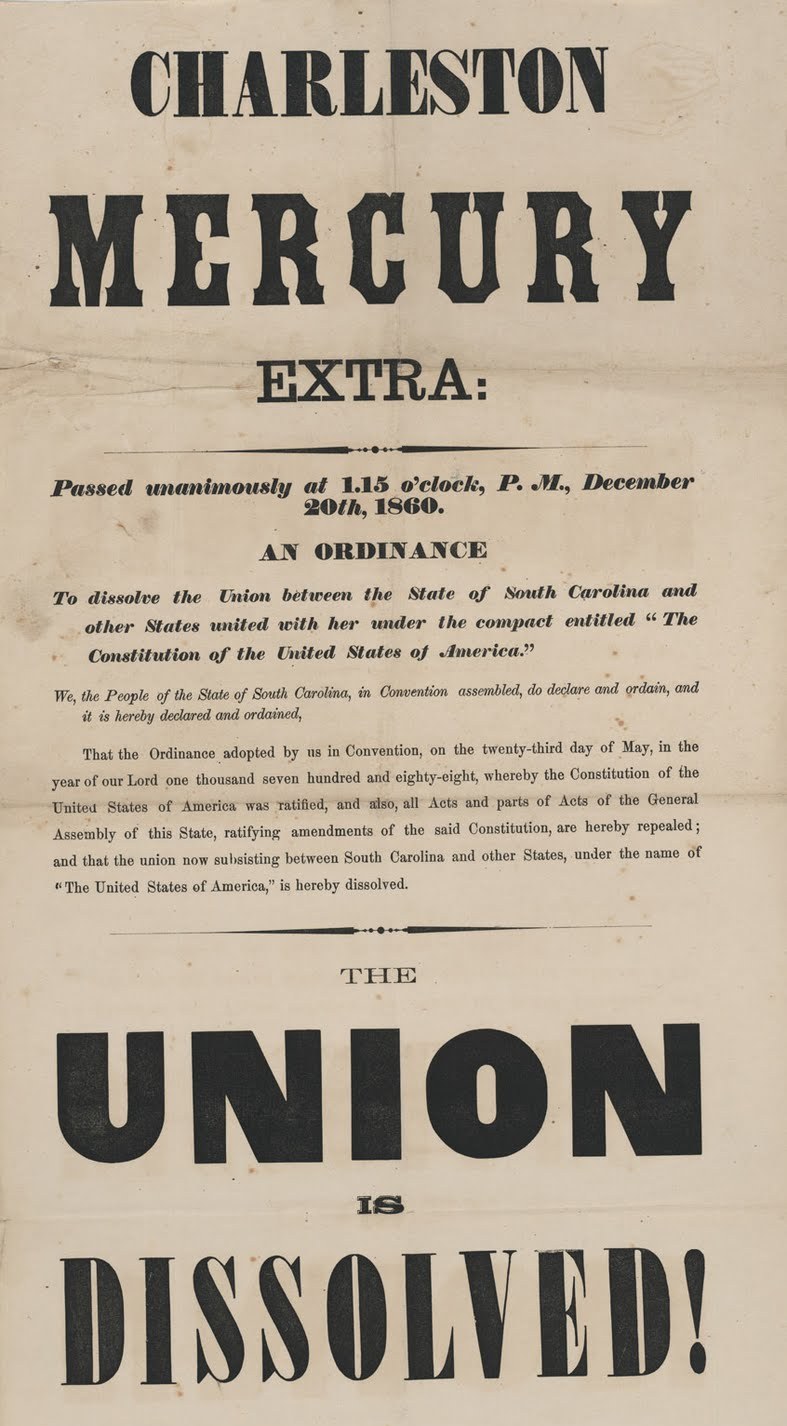
1861



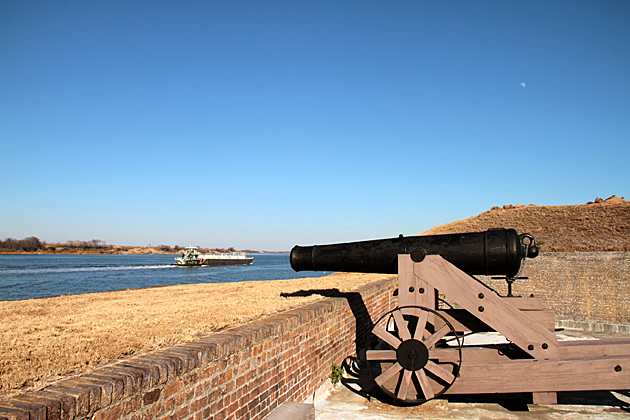
We do further declare and ordain that the union now existing between the State of Georgia and other States under the name of the United States of America is hereby dissolved, and that the State of Georgia is in full possession and exercise of all those rights of sovereignty which belong and appertain to a free and independent State.
Passed January 19, 1861.
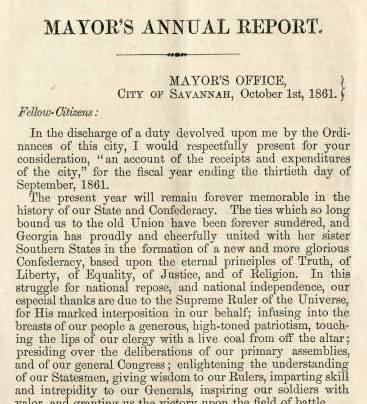
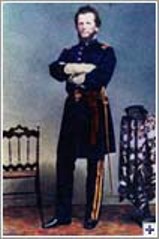
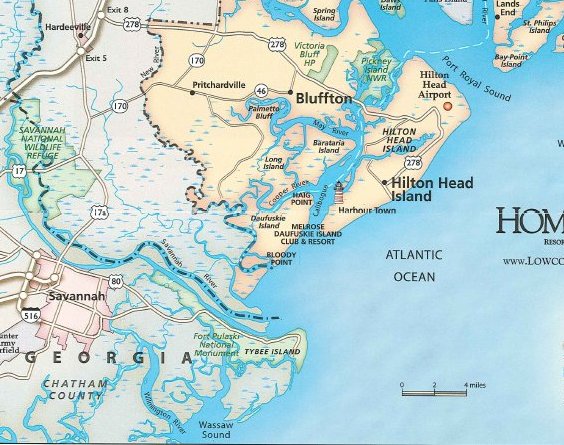
November 7, 1861 - On this same day as the Battle of Port Royal, Lee arrives in South Carolina and makes his headquarters in
Coosawhatchie, a point on the Charleston and Savannah railroad halfway between the two cities. From this point Lee can hear the bombardment in Port Royal Sound.
November 10, 1861 - Robert E. Lee arrives in Savannah and the next day comes to Ft. Pulaski. There he is welcomed by its commander, 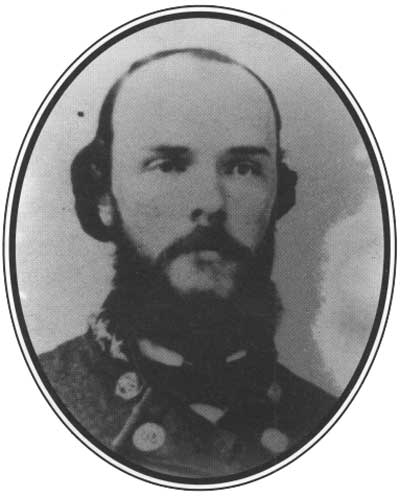
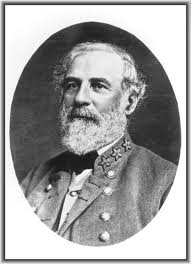 Major Charles H. Olmstead (left). Lee (right) gives instructions on defensive work in the fort.
During this visit Lee points to nearby Tybee Island across the southern branch of the Savannah River, and as famously quoted by Olmstead, says: "...they will make it very warm for you with shells from that point but they cannot breach at that distance."
Major Charles H. Olmstead (left). Lee (right) gives instructions on defensive work in the fort.
During this visit Lee points to nearby Tybee Island across the southern branch of the Savannah River, and as famously quoted by Olmstead, says: "...they will make it very warm for you with shells from that point but they cannot breach at that distance."
November 22 1861 - The Union army, having learned that all confederate guns on Tybee have been removed, decides to occupy Big Tybee Island.

November 24, 1861 - Under the command of Captain Quincy Gillmore (photo), Union troops begin building batteries of guns on the north end of the island. As shown in drawing below, these guns are hauled across Big Tybee Island at night, to avoid detection (from Harper's Weekly Pictorial History of the War of 1861; just to the right of right rear wheel can be seen Ft. Pulaski in the distance).
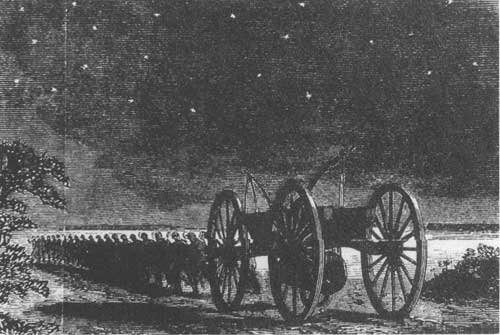
The section of Tybee where Union guns are placed ranges from 1-2 miles from Fort Pulaski, across the southern branch of the Savannah River (see map below). Two of these guns are the new rifle canon never before used by the American army in battle. Altogether, Union forces place 11 guns on Big Tybee.

In addition to preparing for assault on Fort Pulaski, the guns help seal the mouth of the Savannah River from blockade runners, thus helping prevent ships already in port from leaving (like the Fingal, later remade into the
CSS Atlanta).
November 25, 1861 - The first United States Flag raised in Confederate Georgia is hoisted atop the Tybee light house.
December 14, 1861 - Harper's Weekly publishes
drawings of Tybee island, shown below. From top, going clockwise: Tybee lighthouse on Tybee island and Fort Pulaski in distance, on Cockspur Island; the Martello Tower on the northeast corner of Tybee Island (built during War of 1812); soldiers on north end of Tybee Island, with Fort Pulaski in background; Tybee Lighthouse and caretaker's cottage.
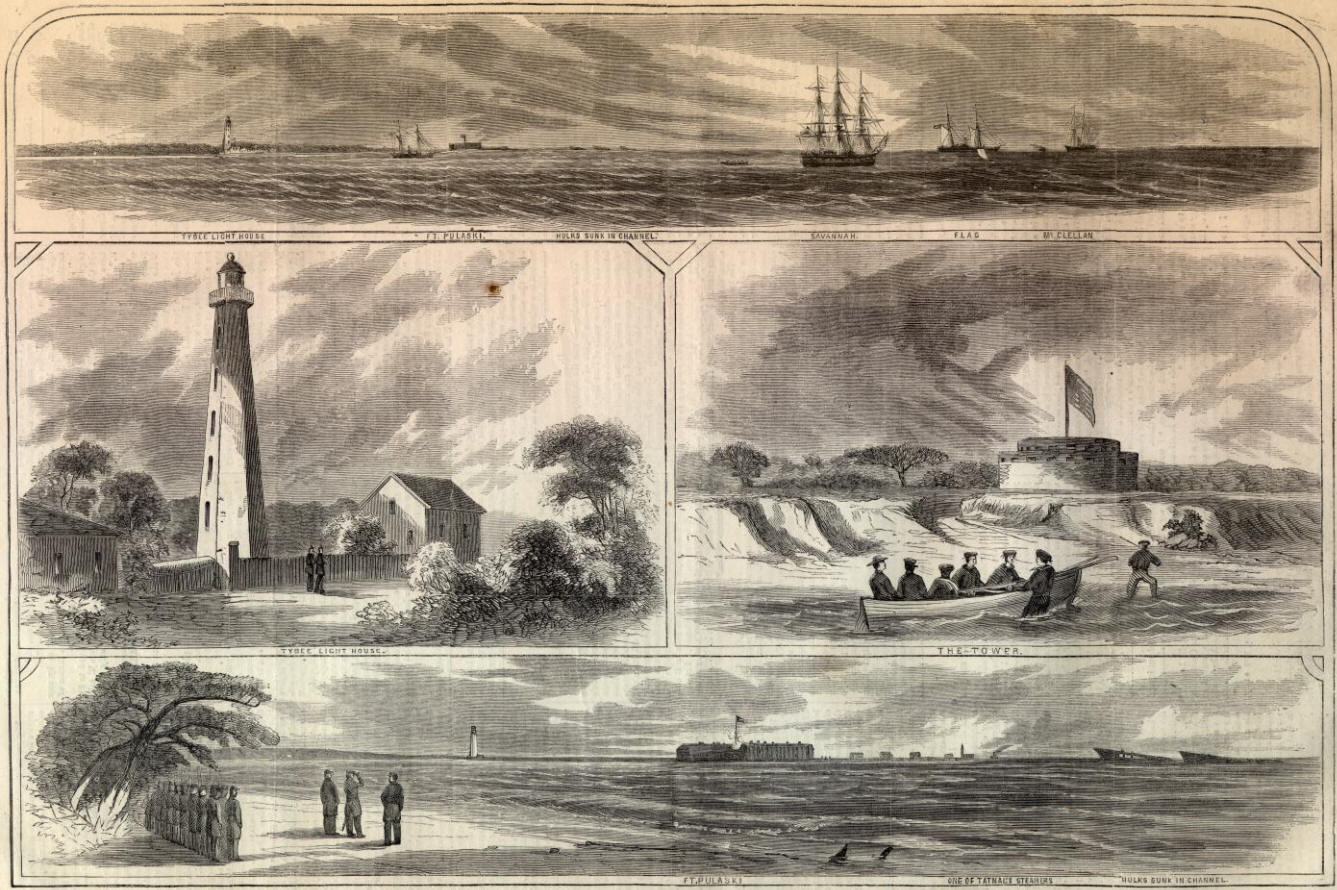
1862
January - February, 1862 - Confederates provision the fort for 6 months. Because of Lee's assessment, they believe the fort is impregnable to canon fire from Big Tybee, and that the only way the Union can take it over is to starve the soldiers.
February 13, 1862 - Commander of the Union ground forces is
General Thomas W. Sherman (photo).
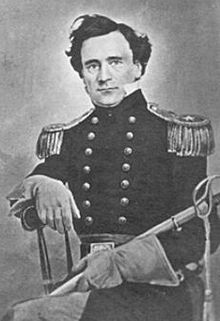 He orders all communications to the fort severed. From Venus Point on the north side of the Savannah River a federal gun fires 9 rounds at the steam ship Ida, which had been making regular runs between Savannah and the fort. From
Brig.-General Quincy Gillmore's report ' Siege and Reduction of Fort Pulaski':
He orders all communications to the fort severed. From Venus Point on the north side of the Savannah River a federal gun fires 9 rounds at the steam ship Ida, which had been making regular runs between Savannah and the fort. From
Brig.-General Quincy Gillmore's report ' Siege and Reduction of Fort Pulaski':
"On the morning of the 13th, the rebel steamer Ida passed down by Venous Point, under full steam. Nine shots were fired at her, striking astern, all but one. Elevation [of guns] good, but not enough allowance made for speed of vessel. I was not in the battery at the time. All the pieces, except one thirty-pounder, recoiled off the platforms. These were at once enlarged to eighteen by seventeen and a half feet." [page 20]
The Ida escapes injury and makes it to Fort Pulaski, Ida then returns to Savannah via the South Channel and Tybee Creek, avoiding the federal cannon. Subsequently the creek is blockand and a firing platform opposite Venus Point cuts the fort off from Savannah. Communication is no longer by boat, but by a messanger who walks the shore and swims the channels at night.
March, 1862 - Lee is recalled to Virginia, to become military advisor to Confederate President Jefferson Davis's office. (Lee will not return to Savannah until after the war is over, when he meets with friend and former Confederate General Joseph Johnston.)
April 8, 1862 - By now Union preparations are complete on Big Tybee Island. They consist of 11 Batteries, each with 1 or more large guns, listed below with their distance from Fort Pulaski (list is from the book Sumter is Avenged!; see sidebar). Their placement is shown in the map of north Tybee Island. The batteries are named by Gillmore for "the persons most prominent or most likely to be so, in political or military service." Included in the batteries are the new rifle canon never before used by the American army in battle. These are the 5 30-pounder Parrotts and the James rifles.
1. Battery, Stanton, 3 heavy 13-inch Mortars, 3,400 yds
2. Battery Grant, 3 heavy 13-inch Mortars, 3,200 yds
3. Battery Lyon, 3 heavy 10-inch Columbiads, 3,100 yds
4. Battery Lincoln, 3 heavy 8-inch Columbiads, 3,100 yds
5. Battery Burnside, 1 heavy 13-inch Mortar, 2,750 yds
6. Battery Sherman, 3 heavy 13-inch Mortars, 2,650 yds
7. Battery Halleck, 2 heavy 13-inch Mortars, 2,400 yds
8. Battery Scott, 3 10-inch Columbiads,1 8-inch Columbiads, 1,740 yds
9. Battery Sigel, 5 30-pounder Parrotts, 1 48-pounder James rifles, 1,650 yds
10. Battery McClellan, 2 84-pounder James rifles; 2 64-pounder James rifles, 1,650 yds
11. Battery Totten, 4 10-inch siege mortars, 1650 yards

Click here for larger image
Below is a photo labeled as
Battery Burnside, with the gun surrounded by soldiers from the 3rd Rhode Island Heavy Artillery unit.
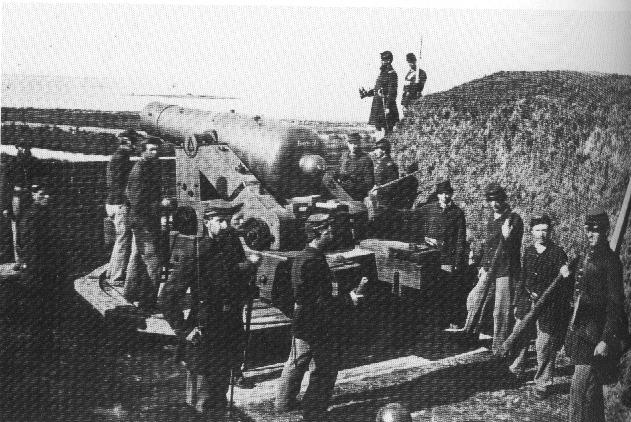
April 9, 1862 - A rainy day, and not a good day for bombardment. The siege's commander,
Brigadier-General Quincy Adams Gillmore (photo on right), waits until April 10.
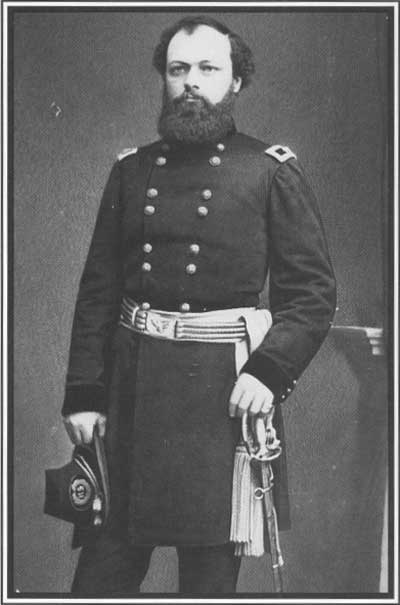
April 10, 1862 - Just before sunrise, Union Lieutenant James Wilson is rowed to Fort Pulaski, to present a written demand for the Fort's surrender. It is delivered to the fort's 25-year-old commander Charles H. Olmstead (see photo under November 10, 1861), who famously replies: "I have to acknowledge receipt of your communication of this date demanding the unconditional surrender of Fort Pulaski. In reply I can only say that I am here to defend not to surrender it." Wilson returns to Tybee and gives the reply to Brig-Gen. Gillmore. Gillmore then gives the order to commence bombardment at 8:15 am. As expected, traditional canon do little damage to the fort's masonry walls, but the new rifled canon tear up the walls and breach one section, the southeast corner. Firing continues without stopping until sunset, at which time only a few shots are fired every hour to keep the confederates awake. In his contemporary account of the battle, Siege and Reduction of Ft. Pulaski, Gillmore writes:
"The first shell was fired at a quarter past eight 0'clock, A.M., from battery Halleck. The other mortar batteries opened one after the other, as rapidly in succession as it was found practicable to determine the approximate ranges, by the use of signals. The guns and columbiads soon followed, so that before half-past nine, A.M., all the batteries were in operation..."
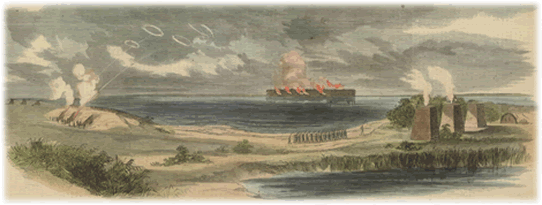
Drawing of Ft. Pulaski under bombardment, as seen from Tybee Island
April 11, 1862 - Intense firing commences at dawn. By 1:30 pm the fort is breached in one section, so that a cannon ball could go right into the interior and possibly blow up 40,000 lbs. of explosives stored in the fort. Olmstead realizes he can no longer save the fort and decides to surrender. That afternoon Captain Gillmore and his party come to the fort to accept surrender. The officers give up their swords at the time of surrender. Altogether 24 officers and 359 men (non-officers) surrender. (Sumter is Avenged!, by Herbert M. Schiller, White Mane Publishing Co., 1995; see Books About Sherman's March, left sidebar.) Olmstead later writes: "Fort Pulaski is the first work that has ever been exposed to the fire of the newly invented rifle canon and the result have proved that brick and mortar cannot stand before them." At the time of surrender Fort Pulaski has 373 men, 24 of whom are officers. The officers give up their swords at the time of surrender.
 Click here for larger image
Click here for larger image
General Gillmore's map of the area at the time of bombardment. His blue-colored gun batteries are arrayed opposite the red-colored fort.
April 12, 1862 - The first full day of federal occupation of Ft. Pulaski.
Some of the Confederate soldiers are sent on steamers north, to prison camp.
Except for the sick and wounded, the rest are sent off on April 13, including Olmstead, the fort's commander. Olmstead writes: "Fort Pulaski is the first work that has ever been exposed to the fire of the newly invented rifle canon and the results have proved that brick and mortar cannot stand before them." (Sumter is Avenged!, by Herbert M. Schiller, White Mane Publishing Co., 1995; see left sidebar)
Fort Pulaski as it looked April 1862, immediately after the bombardment. Note the destruction in the southeastern corner.
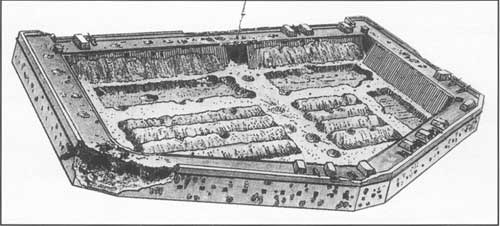
April 19, 1862 - Published in the New York Times, April 19, 1862
May 10, 1862 - Published in Harper's Weekly
GENERAL QUINCY A. GILMORE
WE publish on this page a portrait of GENERAL GILMORE, the hero of Pulaski, from a photograph by Lieutenant Haas.
 General Gilmore was born in Ohio, about thirty-six years ago. He entered the Military Academy at West Point in 1845, and graduated in 1849, at the head of a class of 43 members. He was appointed to the Engineers, and was promoted to a First Lieutenancy in 1856, and to a Captaincy in 1861. From 1849 to 1852 he was engaged on the fortifications at Hampton Roads; from 1852 to 1856 he was instructor of Practical Military Engineering at West Point, and during this time he designed the new Riding School on the crest of the Hill. He served from 1856 to 1861 as Purchasing Agent for the department in New York, and made many friends here. In 1861 he was assigned to the staff of General Sherman, and accompanied him to Port Royal. General Sherman appointed him Brigadier-General of Volunteers—a rank which it is hoped the President will confirm. General Gilmore had entire charge of the siege operations against Fort Pulaski, and it is to his skill that the success of the bombardment is due. The Tribune correspondent well says:
General Gilmore was born in Ohio, about thirty-six years ago. He entered the Military Academy at West Point in 1845, and graduated in 1849, at the head of a class of 43 members. He was appointed to the Engineers, and was promoted to a First Lieutenancy in 1856, and to a Captaincy in 1861. From 1849 to 1852 he was engaged on the fortifications at Hampton Roads; from 1852 to 1856 he was instructor of Practical Military Engineering at West Point, and during this time he designed the new Riding School on the crest of the Hill. He served from 1856 to 1861 as Purchasing Agent for the department in New York, and made many friends here. In 1861 he was assigned to the staff of General Sherman, and accompanied him to Port Royal. General Sherman appointed him Brigadier-General of Volunteers—a rank which it is hoped the President will confirm. General Gilmore had entire charge of the siege operations against Fort Pulaski, and it is to his skill that the success of the bombardment is due. The Tribune correspondent well says:
The result of the efforts to breach a fort of such strength and at such a distance confers high honor on the engineering skill and self-reliant capacity of General Gilmore. Failure in an attempt made in opposition to the opinion of the ablest engineers in the army would have destroyed him. Success, which in this case is wholly attributable to his talent, energy, and independence, deserves a corresponding reward.
June - December, 1862 - By June Union forces have repaired Fort Pulaski and the Union naval blockade of Savannah is near total. Over the next 2 1/2 years - until Union forces capture Savannah December 21, 1864 - it ceases to be a port city. However, the city is well fortified and remains under Confederate control. There are minor skirmishes in the surrounding marshes, and several gunboat attacks on Fort McAllister, but no real military threat to the city until General William Tecumseh Sherman's army marches south from Atlanta, Nov - Dec, 1864.
1863-1864
Though Union troops have taken over Fort Pulaski, Savannah remains well defended until Sherman captures it by land in December 1864.

